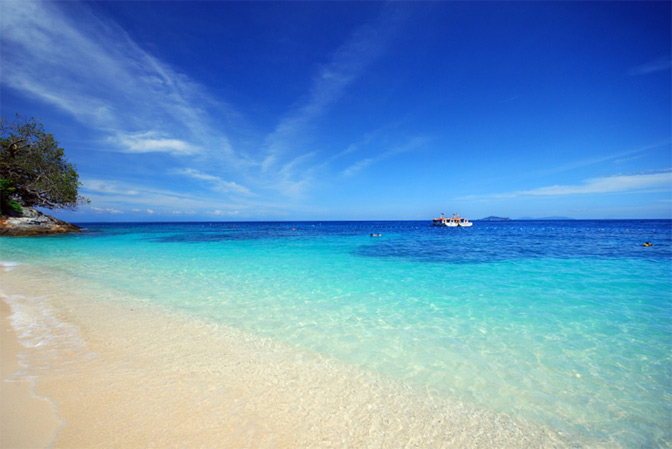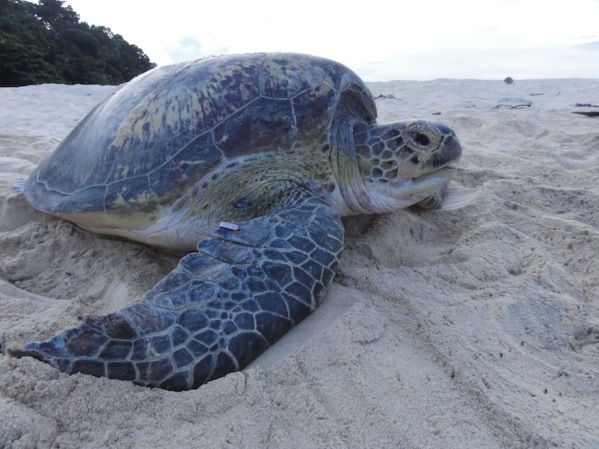Information
Talang- Satang National Park
Sarawak’s first marine national park, Talang-Satang was established with the primary aim of conserving Sarawak’s marine turtle population. The park comprises the coastline and sea surrounding four islands of the southwest coast of Sarawak; Pulau Talang Besar (Greater Talang Island) and Pulau Talang Kecil (Lesser Talang Island) off Sematan, and Pulau Satang Besar (Greater Satang Island) and Pulau Satang Kecil (Lesser Satang Island) off Santubong, near Kuching. These four “Turtle Islands” are responsible for 95% of all the turtle landings in Sarawak. The park also includes the Pulau Tukong Ara-Banun Wildlife Sanctuary, two tiny islets which are important nesting sites for colonies of Bridled Terns and Black-Naped Terns.
Talang-Satang National Park covers a total area of approximately 19,400 hectares (19.4 sq km), and comprises all lands below the high tide marks on the respective islands, and the surrounding seas for a radius of 4.8 km from the highest point on each island. Beautiful shallow reef areas surround all the four islands. The reefs generally consist of several species of hard coral and colonies of soft coral. They provide shelter and resting grounds for sea turtles, and are also important fish breeding areas.
Marine turtles are amongst the world’s longest-lived creatures, with many reaching a lifespan of more than 100 years. Graceful swimmers that spend most of their time underwater, they have survived almost unchanged since the Triassic period, some 200 million years ago. However the breeding habits that have served them so well for so long are now contributing to their extinction.
Marine turtles mature slowly, only starting to breed between 30 and 50 years of age, and once they commence breeding, females usually only produce eggs once every four or five years. They do not lay their eggs on just any beach, but migrate back to their beach of birth, sometimes across distances of more than 3,000 km. How they find their way back to that particular beach is one of nature’s great unsolved mysteries. It is also a major factor in the decline of turtle populations, because as beaches around the world are developed for various purposes, the turtles are unable to move to undisturbed nesting sites.
Other factors that contribute to turtle mortality are deliberate poaching of turtles for meat and tortoiseshell; uncontrolled collecting of turtle eggs; entrapment in fishing nets; destruction of feeding grounds such coral reefs or sea grass beds; and ingestion of plastic bags which some species mistake for jellyfish, part of their natural diet. Even under perfect conditions, survival rates are very low. A female turtle may lay as many as 10,000 eggs in her lifetime, but because of nesting losses due to natural land predators and predation by fish once they reach the sea, as few as 10 hatchlings will survive to reach maturity.
Five marine turtle species are known to nest in Sarawak, with the peak turtle nesting season running from April until September. By far the most important is the Green Turtle (Chelonia mydas), which represents 90% of all turtle landings, mainly on the islands of Talang-Satang national park. The other species that occasionally lands on the islands is the Hawksbill Turtle (Eretmochelys imbricata), whilst the Olive Ridley, Leatherback and Loggerhead Turtles nest primarily on the mainland. All of these species are critically endangered worldwide.
Because of the threat to marine turtles, a conservation programme is under way on Talang-Satang’s three larger islands, and also in Tanjung Datu and Similajau National Parks on the Sarawak mainland. Eggs are either removed from nests and placed in guarded hatcheries, or left in place and guarded round the clock by Sarawak Forestry wardens. After 40 to 60 days incubation, young hatchlings are released at night to reduce losses from predators. In addition, some hatchlings are tagged with miniaturized radio tracking devices to learn more about their ecology and life cycle. The programme appears to be working well, as the number of landings has stabilized at between 1,500 to 3,000 per year over a 10 year period, after sinking to an all time low of under 1,000 in the early 1980s.
Another reason for increased turtle landings is the successful reef-ball programme. Over 2000 concrete reef-balls have been placed in the waters of the National Park. These artificial reef balls not only provide a ready made habitat for coral species; they also provide inter-nesting shelters for turtles; The reef balls’ rough and heavy concrete construction will rip fishing nets to shreds, and therefore prevents encroachment by trawlers. It is difficult to determine exactly what difference they make to actual numbers of landings, but since the introduction of reef-balls the number of dead turtles found in Talang-Satang has decreased dramatically.
The conservation programme has been carefully planned to involve local communities. The traditional rights and practices of the local landowners, villagers, and fishermen are recognized, and Sarawak Forestry works in close co-operation with them to ensure sustainable usage of the resources they are entitled to.
Contact
- CompanyTalang- Satang National Park
- Category Attractions
- Location Kuching, Sarawak
- Tag Attractions in Kuching, Attractions in Sarawak, Talang- Satang National Park, Things to do in Malaysia
Location


